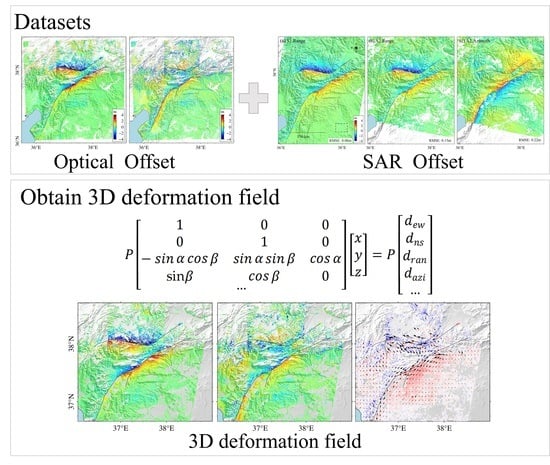Three-Dimensional Deformation of the 2023 Turkey Mw 7.8 and Mw 7.7 Earthquake Sequence Obtained by Fusing Optical and SAR Images
Abstract
1. Introduction
2. Methods and Processes
3. Data Processing
3.1. Geodynamic Setting of the Study Area
3.2. Datasets
3.3. Optical Image Processing
3.4. SAR Image Processing
4. Coseismic 3D Deformation Field
4.1. 3D Deformation Solution
4.2. Accuracy Verification
5. Discussion
5.1. Three-Dimensional Deformation Characteristics
5.2. Fusion of Optical and SAR Data
6. Conclusions
Author Contributions
Funding
Data Availability Statement
Acknowledgments
Conflicts of Interest
References
- Ozawa, S.; Nishimura, T.; Suito, H.; Kobayashi, T.; Tobita, M.; Imakiire, T. Imakiire. Coseismic and postseismic slip of the 2011 magnitude-9 tohoku-oki earthquake. Nature 2011, 475, 373–376. [Google Scholar] [CrossRef]
- Bechor, N.B.D.; Zebker, H.A. Measuring two-dimensional movements using a single insar pair. Geophys. Res. Lett. 2006, 33, L16311. [Google Scholar] [CrossRef]
- He, L.; Feng, G.; Hu, J.; Xu, W.; Liu, J.; Li, Z.; Feng, Z.; Wang, Y.; Lu, H. Surface displacement and source model separation of the two strongest earthquakes during the 2019 ridgecrest sequence: Insights from insar, gps, and optical data. J. Geophys. Res. Solid Earth 2022, 127, e2021JB022779. [Google Scholar] [CrossRef]
- Simons, M.; Fialko, Y.; Rivera, L. Coseismic deformation from the 1999 mw 7.1 hector mine, california, earthquake as inferred from insar and gps observations. Bull. Seismol. Soc. Am. 2002, 92, 1390–1402. [Google Scholar] [CrossRef]
- Scherler, D.; Leprince, S.; Strecker, M.R. Glacier-surface velocities in alpine terrain from optical satellite imagery—Accuracy improvement and quality assessment. Remote Sens. Environ. 2008, 112, 3806–3819. [Google Scholar] [CrossRef]
- Strozzi, T.; Luckman, A.; Murray, T.; Wegmuller, U.; Werner, C. Glacier motion estimation using sar offset-tracking procedures. IEEE Trans. Geosci. Remote Sens. 2002, 40, 2384–2391. [Google Scholar] [CrossRef]
- Zinke, R.; Hollingsworth, J.; Dolan, J.F.; Van Dissen, R. Three-dimensional surface deformation in the 2016 mw7.8 kaikōura, new zealand, earthquake from optical image correlation: Implications for strain localization and long-term evolution of the pacific-australian plate boundary. Geochem. Geophys. Geosyst. 2019, 20, 1609–1628. [Google Scholar] [CrossRef]
- Gray, A.; Short, N.; Mattar, K.; Jezek, K. Velocities and flux of the filchner ice shelf and its tributaries determined from speckle tracking interferometry. Can. J. Remote Sens. 2014, 27, 193–206. [Google Scholar] [CrossRef]
- Rott, H.; Stuefer, M.; Siegel, A.; Skvarca, P.; Eckstaller, A. Mass fluxes and dynamics of moreno glacier, southern patagonia icefield. Geophys. Res. Lett. 1998, 25, 1407–1410. [Google Scholar] [CrossRef]
- Hu, J.; Li, Z.; Ding, X.; Zhu, J.; Zhang, L.; Sun, Q. Zhang and Q. Sun. Resolving three-dimensional surface displacements from insar measurements: A review. Earth-Sci. Rev. 2014, 133, 1–17. [Google Scholar] [CrossRef]
- Michel, R.; Avouac, J.-P.; Taboury, J. Measuring near field coseismic displacements from sar images: Application to the landers earthquake. Geophys. Res. Lett. 1999, 26, 3017–3020. [Google Scholar] [CrossRef]
- Van Puymbroeck, N.; Michel, R.; Binet, R.; Avouac, J.P.; Taboury, J. Measuring earthquakes from optical satellite images. Applied optics. Appl. Opt. 2000, 39, 3017–3020. [Google Scholar] [CrossRef] [PubMed]
- Leprince, S.; Barbot, S.; Ayoub, F.; Avouac, J.-P. Automatic and precise orthorectification, coregistration, and subpixel correlation of satellite images, application to ground deformation measurements. IEEE Trans. Geosci. Remote Sens. 2007, 45, 1529–1558. [Google Scholar] [CrossRef]
- Heid, T.; Kääb, A.E. Evaluation of existing image matching methods for deriving glacier surface displacements globally from optical satellite imagery. Remote Sens. Environ. 2012, 118, 339–355. [Google Scholar] [CrossRef]
- Hermas, E.; Leprince, S.; El-Magd, I.A. Retrieving sand dune movements using sub-pixel correlation of multi-temporal optical remote sensing imagery, northwest sinai peninsula, egypt. Remote Sens. Environ. 2012, 121, 51–60. [Google Scholar] [CrossRef]
- Taylor, M.H.; Leprince, S.; Avouac, J.-P.; Sieh, K. Detecting co-seismic displacements in glaciated regions: An example from the great november 2002 denali earthquake using spot horizontal offsets. Earth Planet. Sci. Lett. 2008, 270, 209–220. [Google Scholar] [CrossRef]
- Ding, C.; Feng, G.; Liao, M.; Tao, P.; Zhang, L.; Xu, Q. Displacement history and potential triggering factors of baige landslides, china revealed by optical imagery time series. Remote Sens. Environ. 2021, 254, 112253. [Google Scholar] [CrossRef]
- Wright, T.J. Toward mapping surface deformation in three dimensions using insar. Geophys. Res. Lett. 2004, 31, 169–178. [Google Scholar] [CrossRef]
- Jung, H.-S.; Yun, S.-H.; Jo, M.-J. An improvement of multiple-aperture sar interferometry performance in the presence of complex and large line-of-sight deformation. IEEE J. Sel. Top. Appl. Earth Obs. Remote Sens. 2015, 8, 1743–1752. [Google Scholar] [CrossRef]
- Hu, J.; Li, Z.; Zhu, J.; Ren, X.; Ding, X. Inferring three-dimensional surface displacement field by combining sar interferometric phase and amplitude information of ascending and descending orbits. Sci. China Earth Sci. 2010, 53, 550–560. [Google Scholar] [CrossRef]
- Fialko, Y.; Sandwell, D.; Simons, M.; Rosen, P. Three-dimensional deformation caused by the bam, iran, earthquake and the origin of shallow slip deficit. Nature 2005, 435, 295–299. [Google Scholar] [CrossRef] [PubMed]
- Gökkaya, K. Geographic analysis of earthquake damage in turkey between 1900 and 2012. Geomat. Nat. Hazards Risk 2016, 7, 1948–1961. [Google Scholar] [CrossRef]
- McClusky, S.; Balassanian, S.; Barka, A.; Demir, C.; Ergintav, S.; Georgiev, I.; Gurkan, O.; Hamburger, M.; Hurst, K.; Kahle, H.; et al. Global positioning system constraints on plate kinematics and dynamics in the eastern mediterranean and caucasus. J. Geophys. Res. 2000, 105, 5695–5719. [Google Scholar] [CrossRef]
- Dogru, F. The importance of atmospheric corrections on insar surveys over turkey case study of tectonic deformation of bodrum-kos earthquake. Pure Appl. Geophys 2020, 117, 5761–5780. [Google Scholar] [CrossRef]
- Lazos, I.; Sboras, S.; Pikridas, C.; Pavlides, S.; Chatzipetros, A. Geodetic analysis of the tectonic crustal deformation pattern in the north aegean sea, greece. Mediterr. Geosci. Rev. 2021, 3, 79–94. [Google Scholar] [CrossRef]
- Imamoglu, M.; Kahraman, F.; Cakir, Z.; Sanli, F.B. Ground deformation analysis of bolvadin (w. Turkey) by means of multi-temporal insar techniques and sentinel-1 data. Remote Sens 2019, 11, 1069. [Google Scholar] [CrossRef]
- Xu, J.; Liu, C.; Xiong, X. Xiong. Source process of the 24 january 2020 mw 6.7 east anatolian fault zone, turkey, earthquake. Seismol. Res. Lett. 2020, 91, 3120–3128. [Google Scholar] [CrossRef]
- Duman, T.Y.; Emre, Ö. The east anatolian fault: Geometry, segmentation and jog characteristics. Geol. Soc. Lond. Spec. Publ. 2013, 372, 495–529. [Google Scholar] [CrossRef]
- Dal Zilio, L.; Ampuero, J.-P. Earthquake doublet in Turkey and Syria. Commun. Earth Environ. 2023, 4, 71. [Google Scholar] [CrossRef]
- Gülerce, Z.; Shah, S.T.; Menekşe, A.; Özacar, A.A.; Kaymakci, N.; Çetin, K.Ö. Probabilistic seismic-hazard assessment for east anatolian fault zone using planar fault source models. Bull. Seismol. Soc. Am. 2017, 107, 2353–2366. [Google Scholar] [CrossRef]
- Lijia, H.; Guangcai, F.; Zhixiong, F.; Hua, G. Coseismic displacements of 2016 mw7. 8 kaikoura, new zealand earthquake, using sentinel-2 optical images. Acta Geod. Cartogr. Sin. 2019, 48, 339–351. [Google Scholar] [CrossRef]
- Michel, R.; Avouac, J.-P. Coseismic surface deformation from air photos: The kickapoo step over in the 1992 landers rupture. J. Geophys. Res. Solid Earth 2006, 111, B03408. [Google Scholar] [CrossRef]
- Li, Z.; Ding, X.; Huang, C.; Zhu, J.; Chen, Y. Improved filtering parameter determination for the goldstein radar interferogram filter. ISPRS J. Photogramm. Remote Sens. 2008, 63, 621–634. [Google Scholar] [CrossRef]
- Sudhaus, H.; Jónsson, S. Improved source modelling through combined use of insar and gps under consideration of correlated data errors: Application to the june 2000 kleifarvatn earthquake, iceland. Geophys. J. Int. 2009, 176, 389–404. [Google Scholar] [CrossRef]
- Magen, Y.; Ziv, A.; Inbal, A.; Baer, G.; Hollingsworth, J. Fault rerupture during the July 2019 ridgecrest earthquake pair from joint slip inversion of insar, optical imagery, and gps. Bull. Seismol. Soc. Am. 2020, 110, 1627–1643. [Google Scholar] [CrossRef]
- Nalbant, S.S.; McCloskey, J.; Steacy, S.; Barka, A.A. Stress accumulation and increased seismic risk in eastern turkey. Earth Planet. Sci. Lett. 2002, 195, 291–298. [Google Scholar] [CrossRef]
- Necsoiu, M.; Leprince, S.; Hooper, D.M.; Dinwiddie, C.L.; McGinnis, R.N.; Walter, G.R. Monitoring migration rates of an active subarctic dune field using optical imagery. Remote Sens. Environ. 2009, 113, 2441–2447. [Google Scholar] [CrossRef]
- Bontemps, N.; Lacroix, P.; Doin, M.-P. Inversion of deformation fields time-series from optical images, and application to the long term kinematics of slow-moving landslides in Peru. Remote Sens. Environ. 2018, 210, 144–158. [Google Scholar] [CrossRef]
- Xiong, Z.; Feng, G.; Feng, Z.; Miao, L.; Wang, Y.; Yang, D.; Luo, S. Pre- and post-failure spatial-temporal deformation pattern of the baige landslide retrieved from multiple radar and optical satellite images. Eng. Geol. 2020, 279, 105880. [Google Scholar] [CrossRef]


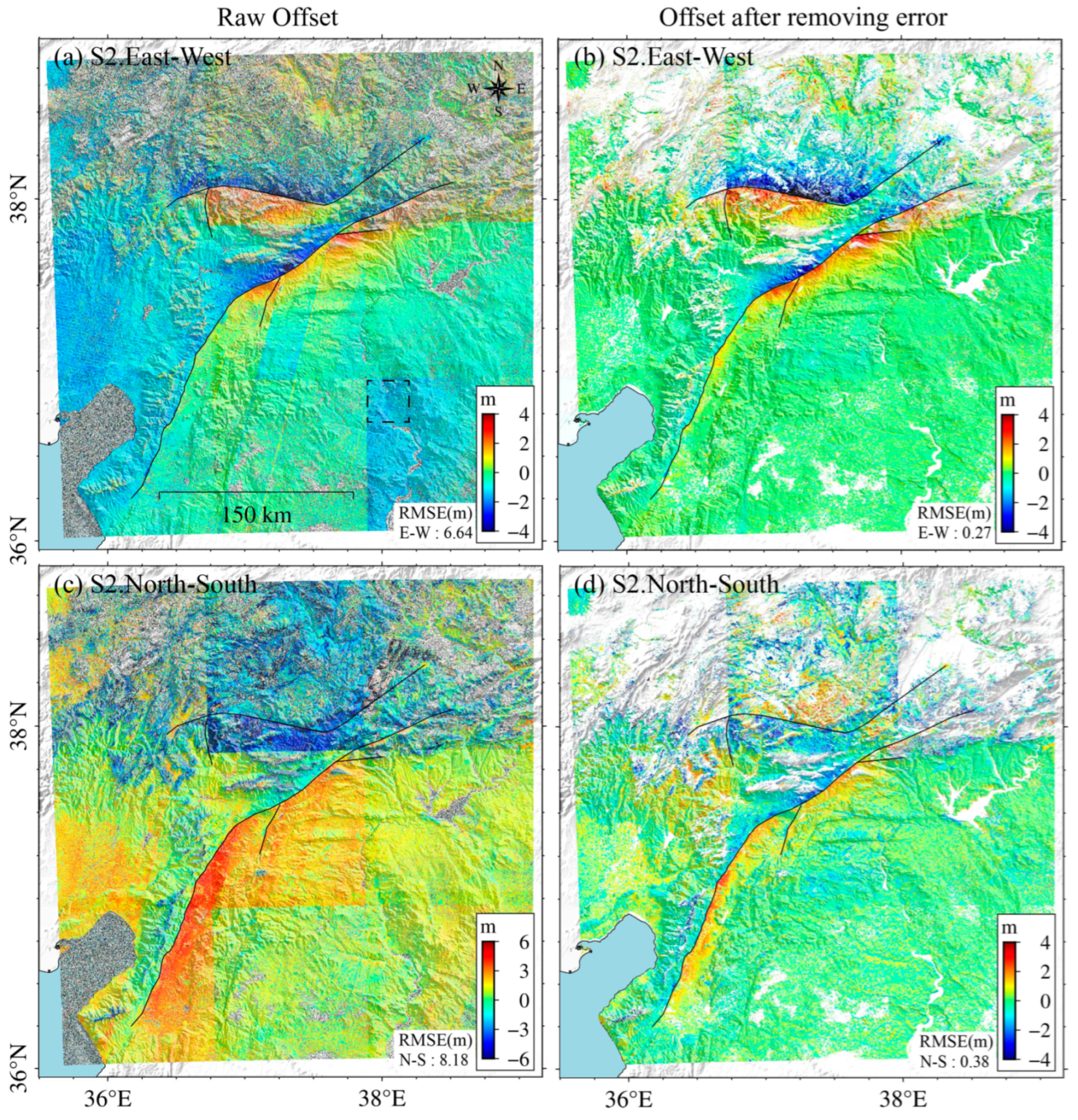
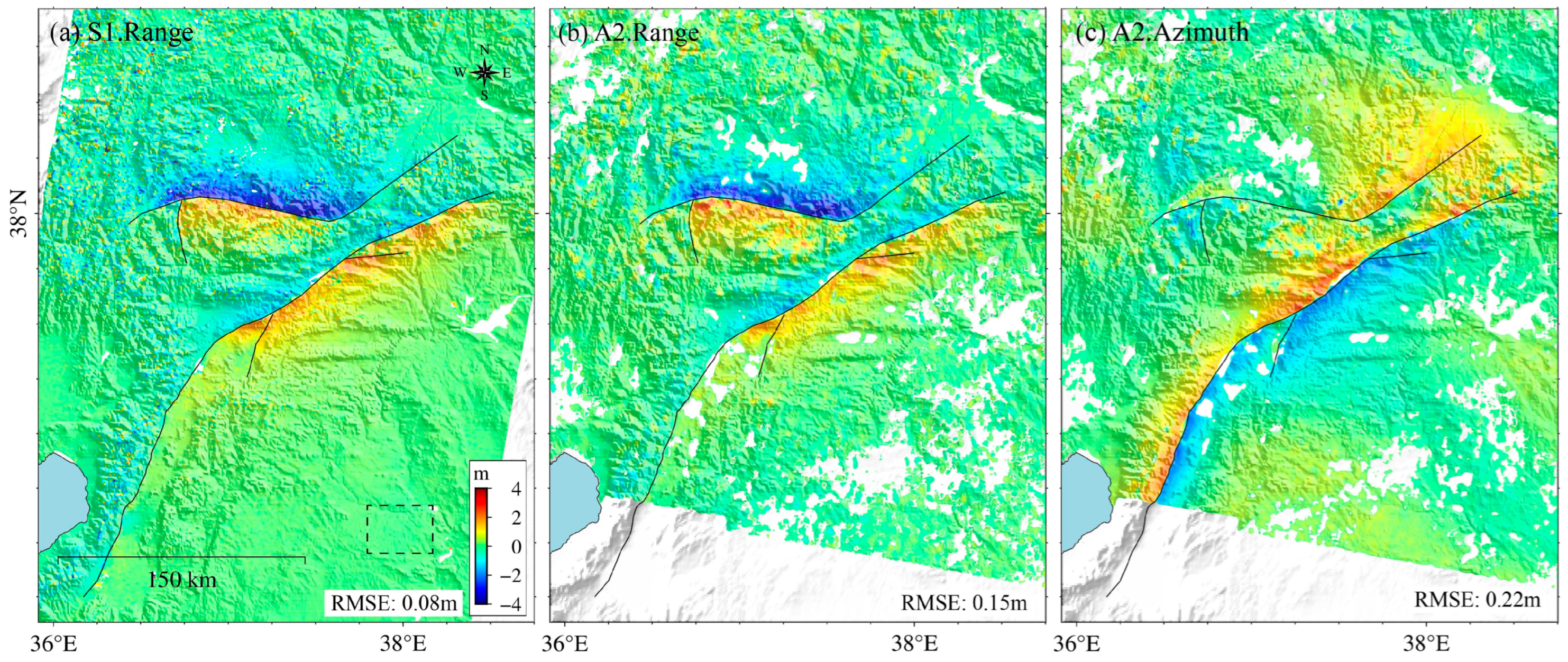
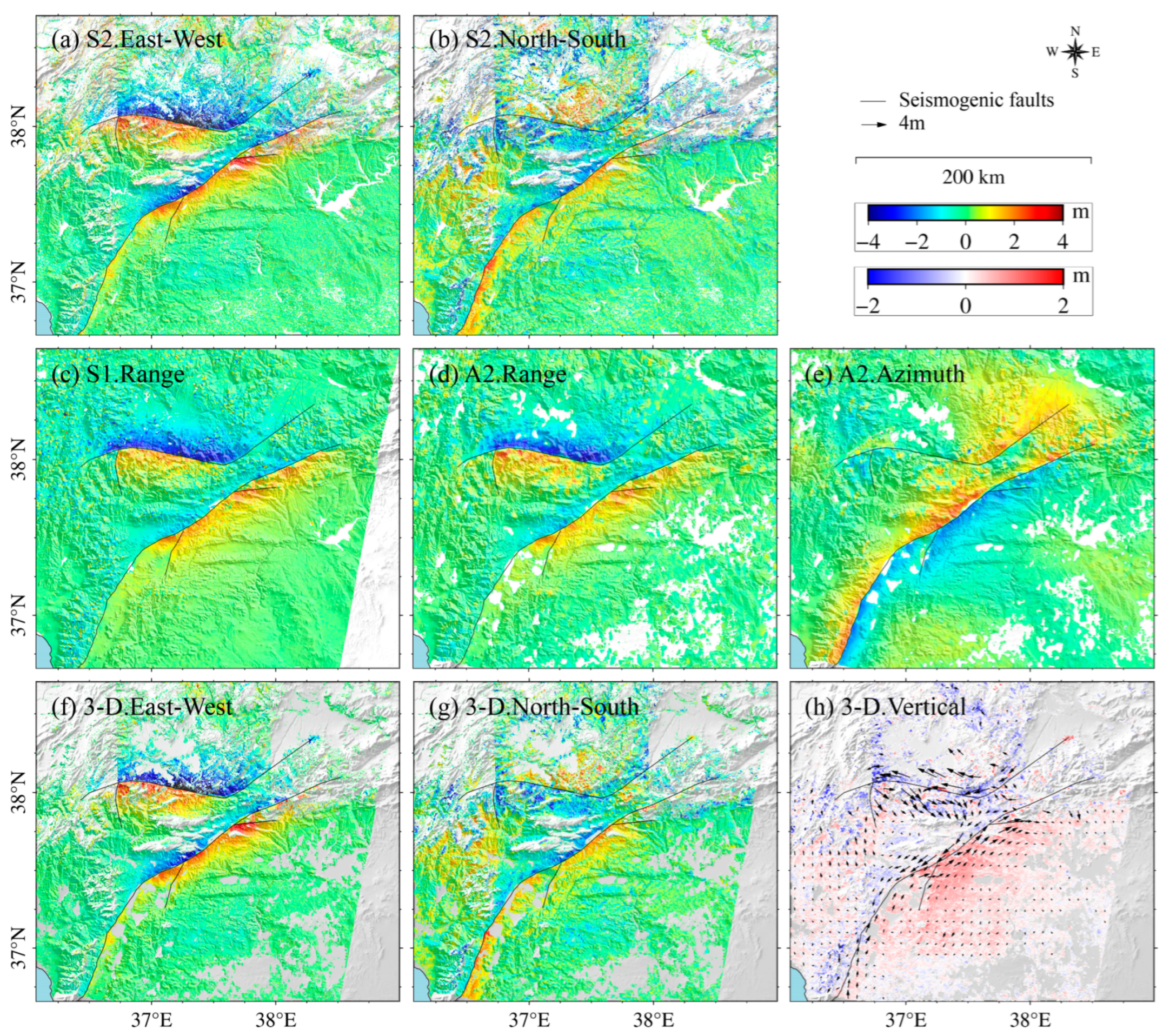
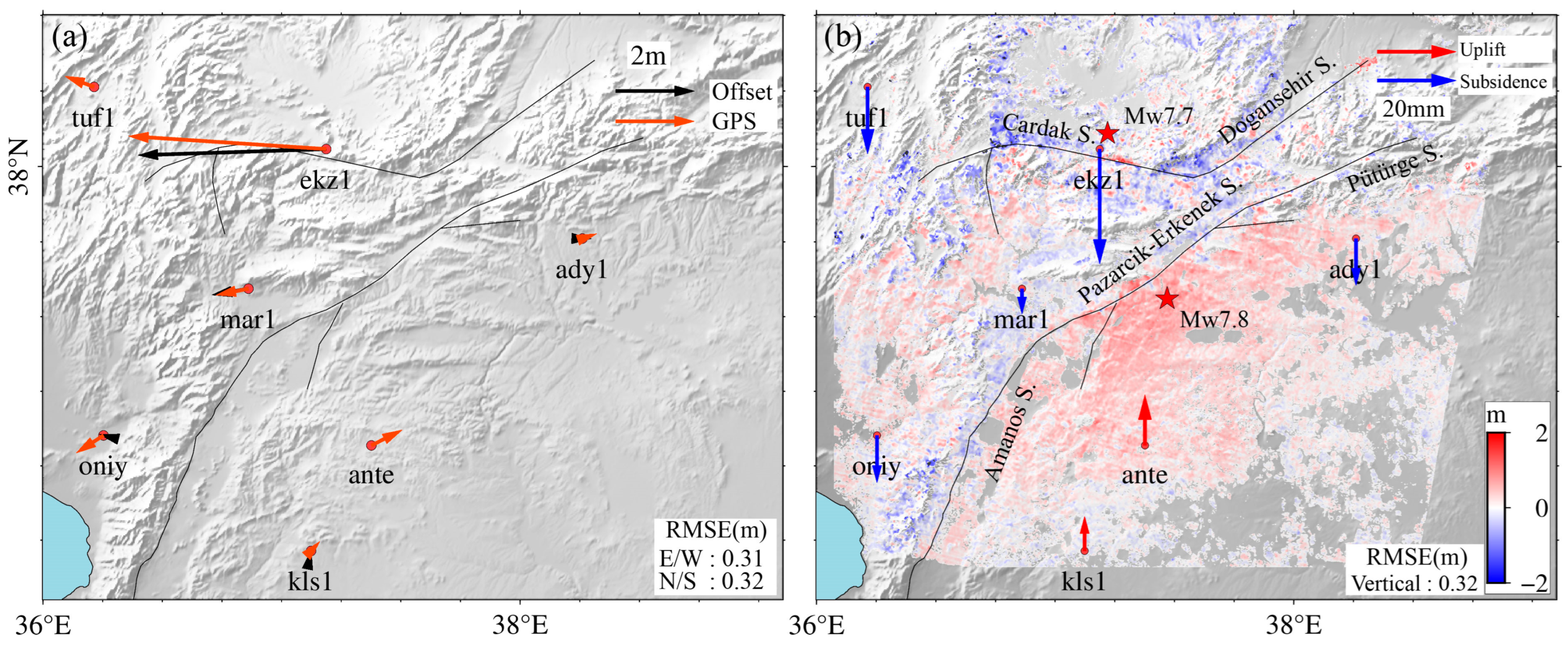
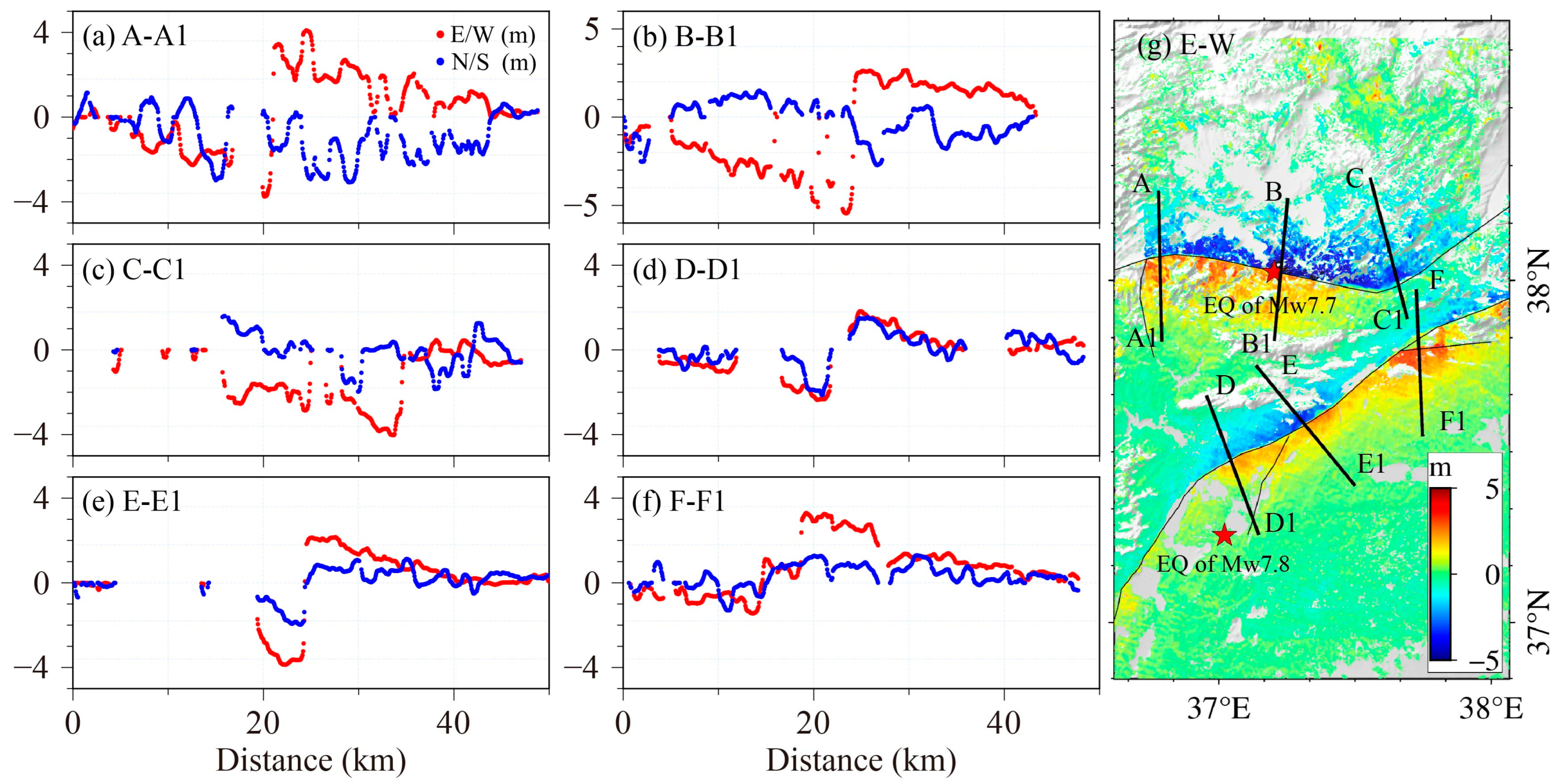
| Sensor | Master Image | Cloud | Slave Image | Cloud | Frame Number | Data Processing Method |
|---|---|---|---|---|---|---|
| Sentinel-2 | 20 January 2023 | 0.001 | 1 March 2023 | 16.88 | T37SBC | SPC |
| 25 January 2023 | 0.075 | 1 March 2023 | 6.188 | T37SBB | ||
| 25 January 2023 | 0.106 | 1 March 2023 | 0.280 | T37SBA | ||
| 10 January 2023 | 0.018 | 9 February 2023 | 0.056 | T37SCC | ||
| 25 January 2023 | 0.165 | 1 March 2023 | 5.402 | T37SCB | ||
| 20 January 2023 | 0.438 | 19 February 2023 | 5.924 | T37SCA | ||
| 13 November 2022 | 0.794 | 16 February 2023 | 13.63 | T37SDC | ||
| 22 January 2023 | 0.105 | 21 February 2023 | 0.582 | T37SDB | ||
| 22 January 2023 | 12.08 | 16 February 2023 | 0.104 | T37SDA | ||
| Sentinel-1 | 29 January 2023 | — | 21 February 2023 | — | Frame 471 Path 21 | POT |
| 29 January 2023 | — | 21 February 2023 | — | Frame 465 Path 21 | ||
| 29 January 2023 | — | 21 February 2023 | — | Frame 460 Path 21 | ||
| ALOS-2 | 16 September 2022 | — | 17 February 2023 | — | Row 2850 Path 77 |
Disclaimer/Publisher’s Note: The statements, opinions and data contained in all publications are solely those of the individual author(s) and contributor(s) and not of MDPI and/or the editor(s). MDPI and/or the editor(s) disclaim responsibility for any injury to people or property resulting from any ideas, methods, instructions or products referred to in the content. |
© 2023 by the authors. Licensee MDPI, Basel, Switzerland. This article is an open access article distributed under the terms and conditions of the Creative Commons Attribution (CC BY) license (https://creativecommons.org/licenses/by/4.0/).
Share and Cite
An, Q.; Feng, G.; He, L.; Xiong, Z.; Lu, H.; Wang, X.; Wei, J. Three-Dimensional Deformation of the 2023 Turkey Mw 7.8 and Mw 7.7 Earthquake Sequence Obtained by Fusing Optical and SAR Images. Remote Sens. 2023, 15, 2656. https://doi.org/10.3390/rs15102656
An Q, Feng G, He L, Xiong Z, Lu H, Wang X, Wei J. Three-Dimensional Deformation of the 2023 Turkey Mw 7.8 and Mw 7.7 Earthquake Sequence Obtained by Fusing Optical and SAR Images. Remote Sensing. 2023; 15(10):2656. https://doi.org/10.3390/rs15102656
Chicago/Turabian StyleAn, Qi, Guangcai Feng, Lijia He, Zhiqiang Xiong, Hao Lu, Xiuhua Wang, and Jianchao Wei. 2023. "Three-Dimensional Deformation of the 2023 Turkey Mw 7.8 and Mw 7.7 Earthquake Sequence Obtained by Fusing Optical and SAR Images" Remote Sensing 15, no. 10: 2656. https://doi.org/10.3390/rs15102656
APA StyleAn, Q., Feng, G., He, L., Xiong, Z., Lu, H., Wang, X., & Wei, J. (2023). Three-Dimensional Deformation of the 2023 Turkey Mw 7.8 and Mw 7.7 Earthquake Sequence Obtained by Fusing Optical and SAR Images. Remote Sensing, 15(10), 2656. https://doi.org/10.3390/rs15102656







